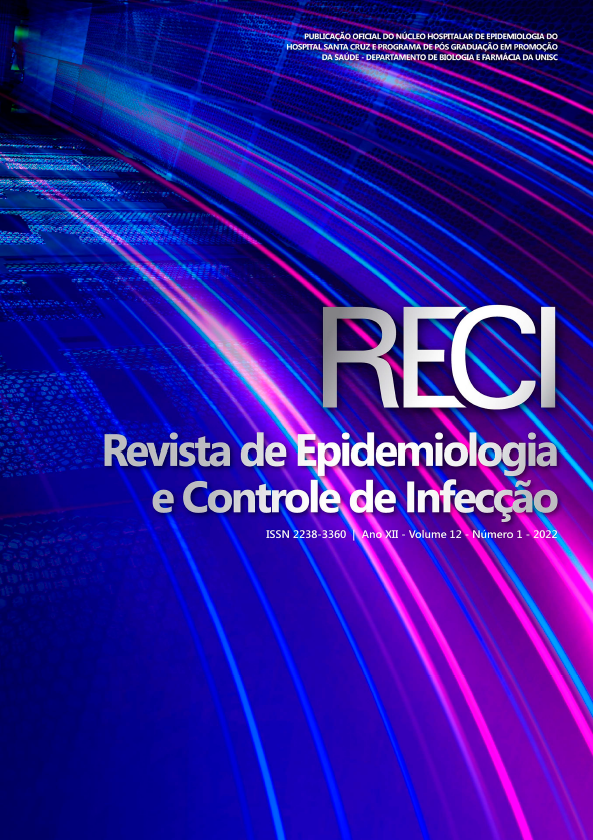The consequences of the Sars-CoV-2 pandemic on medical education in the fight against leprosy
DOI:
https://doi.org/10.17058/reci.v12i1.16870Keywords:
Doenças Tropicais Negligenciadas, Hanseníase, Erros de Diagnóstico, Educação Médica, Pesquisa sobre Prestação de Cuidados de SaúdeAbstract
Background and objectives: Leprosy is an infectious disease in which early diagnosis is a decisive factor in preventing impairment and disabilities. This study sought to analyze the panorama of leprosy between 2016 and 2021 in the state of Rio Grande do Sul, revealing the importance of medical education in the context of Neglected Tropical Diseases during the Sars-CoV-2 pandemic. Methods: Cross-sectional study using the database of the State Health Surveillance Center of Rio Grande do Sul. Data collection included leprosy data in individuals living in the state of Rio Grande do Sul (RS), from 2016 to 2021. The variables analyzed were confirmed cases of leprosy, reported cases, number of cases regarding the operational classifications of leprosy, the therapeutic regimen and the number of cases according to the degrees of physical disability. Results: In the analyzed period, 725 cases of leprosy were confirmed, 70% in 2016, 2017 and 2018. Of the total number of cases, 88% were the multibacillary form of the disease, 50% had some degree of physical disability at the time diagnosis and 80% performed the standard therapeutic regimen. Conclusion: There is a delay in the diagnosis of leprosy and there is underdiagnosis of the disease in the state of Rio Grande do Sul, which highlights the need to reaffirm educational practices on mycobacteriosis.
Downloads
References
Kundakci N, Erdem C. Leprosy: A great imitator. Clin Dermatol. 2019;37(3):200–12. https://doi.org/10.1016/j.clindermatol.2019.01.002
Ministério da Saúde (BR). Secretaria de Vigilância em Saúde. Departamento de Vigilância das Doenças Transmissíveis. Guia prático sobre a hanseníase. 2017. 68p. http://bvsms.saude.gov.br/bvs/publicacoes/guia_pratico_ hanseniase.pdf
OMS. Diretrizes para o diagnóstico, tratamento e prevenção da hanseníase. Organ Mund da Saúde. 2019. https://apps.who.int/iris/handle/10665/274127
Martins-Melo FR, Carneiro M, Ramos AN, et al. The burden of Neglected Tropical Diseases in Brazil, 1990-2016: A subnational analysis from the Global Burden of Disease Study 2016. PLoS Negl Trop Dis. 2018;12(6):1–24. https://doi.org/10.1371/journal.pntd.0006559
Teixeira CSS, Pescarini JM, Alves FJO, et al. Incidence of and Factors Associated with Leprosy among Household Contacts of Patients with Leprosy in Brazil. JAMA Dermatology. 2020;156(6):640–8.10. https://doi.org/1001/jamadermatol.2020.0653
OMS. Rumo à zero hanseníase Rumo à zero hanseníase Estratégia Global de Hanseníase. 2021;1-30. https://www.who.int/pt/publications/i/item/9789290228509
WHO. Ending the neglect to attain the Sustainable Development Goals: a road map for neglected tropical diseases 2021–2030. 2021;: https://apps.who.int/iris/rest/bitstreams/1277958/retrieve
Foss NT, Motta ACF. Leprosy, a neglected disease that causes a wide variety of clinical conditions in tropical countries. Mem Inst Oswaldo Cruz. 2012;107(SUPPL.1):28–33. https://doi.org/10.1590/S0102-311X2011001000020
Leon KE, Jacob JT, Franco-Paredes C, et al. Delayed diagnosis, leprosy reactions, and nerve injury among individuals with Hansen’s disease seen at a United States clinic. Open Forum Infect Dis. 2016;3(2):1–4. https://doi.org/10.1093/ofid/ofw063
WHO. Estratégia Global para Hanseníase 2016-2020. Estratégia Global para Hanseniase 2016-2020. 2016. 1–23 p. http://apps.who.int/iris/bitstream/10665/208824/8/9789290225201-Portuguese.pdf
Fischer M. Leprosy – an overview of clinical features, diagnosis, and treatment. JDDG - J Ger Soc Dermatology. 2017;15(8):801–27. https://doi.org/10.1111/ddg.13301
WHO. Ending the neglect to attain the Sustainable Development Goals: a road map for neglected tropical diseases 2021–2030. 2021. https://apps.who.int/iris/rest/bitstreams/1277958/retrieve
Kaul V, Moraes AG De, Khateeb D, et al. Medical Education During the COVID-19 Pandemic. Chest. 2021;159(5):1949–60. https://doi.org/10.1016/j.chest.2020.12.026
Neves KVRN, Nobre ML, Machado LMG, et al. Misdiagnosis ofleprosy in Brazil in the period 2003 - 2017: spatial pattern and associated factors. Acta Trop. 2021;215:105791. https://doi.org/10.1016/j.actatropica.2020.105791
Carneiro M, Possuelo LG, Valim ARM. Neuropatia por hanseníase: atraso no diagnóstico ou um diagnóstico difícil? Leprosy neuropathy: delayed diagnosis or a difficult diagnosis? Cad Saude Publica. 2011;27(10):2070. https://doi.org/10.1590/S0102-311X2011001000020
Ministério da Saúde (BR). Secretaria de Vigilância em Saúde. Departamento de Vigilância das Doenças Transmissíveis.Boletim Epidemiológico - Hanseníase. 2021 56p. https://www.gov.br/saude/pt-br/assuntos/media/pdf/2021/fevereiro/12/boletim-hanseniase-_-25-01.pdf
Henry M, GalAn N, Teasdale K, et al. Factors Contributing to the Delay in Diagnosis and Continued Transmission of Leprosy in Brazil – An Explorative, Quantitative, Questionnaire Based Study. PLoS Negl Trop Dis. 2016;10(3):1–12. https://doi.org/10.1371/journal.pntd.0004542
Kumar RR, Jha S, Dhooria A, et al. A case of leprosy misdiagnosed as lupus. J Clin Rheumatol. 2020;26(8):e301–2.10. https://doi.org/1097/RHU.0000000000001154
Ribeiro MDA, Silva JCA, Oliveira SB. Estudo epidemiológico da hanseníase no Brasil: reflexão sobre as metas de eliminação. Rev Panam Salud Publica. 2018;42:e42. https://doi.org/10.26633/RPSP.2018.42
Downloads
Published
How to Cite
Issue
Section
License
Copyright (c) 2022 Henrique Ziembowicz, Irene Souza, Jordana Vargas Peruzzo, Larissa de Camargo Subtil, Lorenzo Garcia Onófrio, Manoela Badinelli Vaucher

This work is licensed under a Creative Commons Attribution 4.0 International License.
The author must state that the paper is original (has not been published previously), not infringing any copyright or other ownership right involving third parties. Once the paper is submitted, the Journal reserves the right to make normative changes, such as spelling and grammar, in order to maintain the language standard, but respecting the author’s style. The published papers become ownership of RECI, considering that all the opinions expressed by the authors are their responsibility. Because we are an open access journal, we allow free use of articles in educational and scientific applications provided the source is cited under the Creative Commons CC-BY license.


